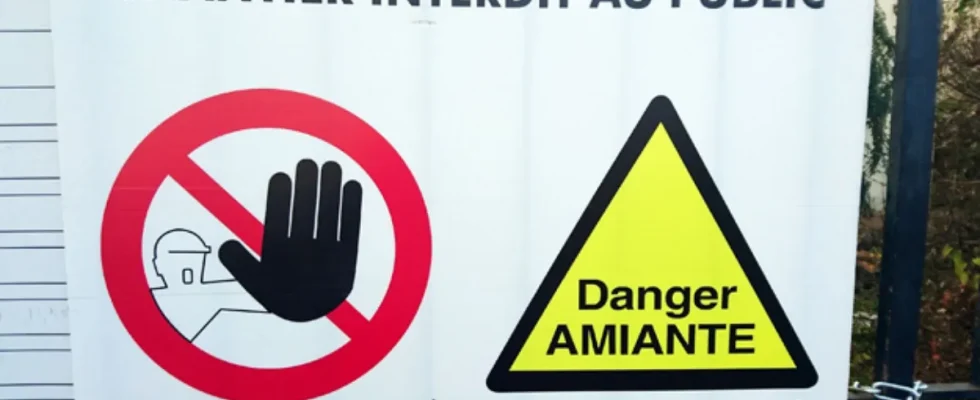A steering committee and data in open data: this is what the Paris City Hall promises, two weeks after the revelation to the public of an investigation by the Vert de rage collective on the presence of asbestos, a carcinogenic material, in 70% of Parisian public schools.
According to our information, a wish should be presented by the executive, and in all likelihood voted on by the Council of Paris on July 4, 5 and 6, which promises to “continue the public communication of the census of the presence of asbestos in the entire Parisian building” and “to further intensify the efforts already made to combat exposure to asbestos”, according to the text sent by Anne Souyris, Deputy Mayor of Paris in charge of public health, interviewed by 20 minutes.
“All folders [les ”dossiers techniques amiantes” ou DTA, qui comprennent les évaluations de risque et doivent être effectués tous les trois ans en cas de risque] will be accessible in open data on paris.fr,” explains Anne Souyris. “We are going to set up a steering committee on the model of that for lead which will make it possible to intensify the efforts already made. We will do this with the federations of parents of students, teachers, etc. This will be an opportunity to do things better, “says the assistant, who ensures that the areas most at risk, say from “list A”, where asbestos can be released in the event of simple wear, have already been treated. “It’s completely over, there are no more at all” she assures. The town hall also analyzes between 200 and 250 schools and between 30 and 40 colleges each year, in particular during works, which represent a risk of exposure for workers.
Asbestos is not monitored enough
If the presence of asbestos is not in itself dangerous, because it can be encapsulated in concrete or another material that prevents contact with the lungs, the problem is, according to the Vert de rage collective, that it does not is not monitored enough. A third of the schools in France built before July 1, 1997 and which nevertheless have the obligation to carry out an Asbestos Technical Diagnosis (DTA), have never carried out one. And school staff often don’t know where the asbestos is located, and can take risks without knowing it.
“If there is an asbestos partition behind you in a class and you pin something on it, you are exposing yourself to asbestos fibers”, explained in mid-June, when the investigation of the investigative program, Mathilde Cusin, journalist at Vert de Rage. Asbestos is carcinogenic, and a single fiber can cause cancer, recalled the collective of documentary filmmakers.
“It’s not moving fast enough”
“It is not uncommon to note that some schools or early childhood establishments have still not taken this step. [le DTA]while the contaminated buildings already identified are still awaiting financial means in order to carry out the necessary work”, also accuses the Changer Paris group, which has submitted a wish on the subject.
“Asbestos could be responsible for nearly a hundred thousand deaths from cancer in France by 2050. We want to avoid finding children attending school in Paris among the victims”, worries David Alphand, adviser of Paris and elected from the right-wing group (mainly LR), citing estimates from the High Council for Public Health (HSCP). David Alphand had requested in 2009 the creation of a position for a “Mr. Asbestos”, a wish rejected by the executive.
The Modem group and the Les Ecologistes group also expressed concerns ahead of the next Council of Paris, the latter group insisting that “a census of the presence of asbestos in all Parisian buildings, in connection with the state service”. “The city really needs to give itself the means, there is no need for work to be done during the week but it is not progressing quickly enough”, lamented Thursday Nour Durand-Rocher, from the same group Les Ecologistes.
“We still have it for years or decades”
“We made asbestos files on the Parisian building, all the public buildings were made”, defends Anne Souyris, also at Les Ecologistes. The problem is that the transformation of the frame is extremely expensive. “Removing asbestos from Paris is a huge project, 4 to 5 billion per year for ten years in France”, explains Chloé Sagaspe, elected member of the Les Ecologistes group. According to Anne Souyris, the town hall spends between 1.5 and several million each year for asbestos removal. “It’s a colossal budgetary effort… We still have it for years or decades”, warns Cyrielle Peyraube, chief of staff of Patrick Bloche, the assistant for Education. Since 1997, about 200 schools or colleges have been completely removed from asbestos, according to the assistant, out of about 800 establishments.
In fact, according to Chloé Sagaspe, the “health scandal” is “far from over”. And it is not because it is expensive that we should not act up to the challenges: “We must assume the fact that yes we will have to remove asbestos, and that yes we will need public money”. Even if the elected official wants to put the responsibilities in their place: “It is not the City of Paris which is responsible for it, it is a state scandal. Because it was not the Paris City Hall that decided to put asbestos in schools. “The wish of the executive also challenges “the government and the national representation” for better financing of the communities on this subject.

